Sun Valley, Idaho 作者: 来源: 发布时间:2021-11-03
I.Population and Area
₋Area
Land: 9.58 sq mi (24.80 km2)
₋Population
Total: 1,473
Density: 155.36/sq mi (59.99/km2)
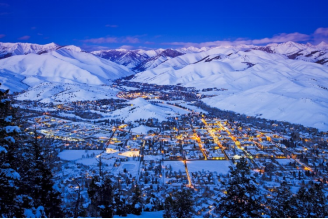
II.Natural Geography
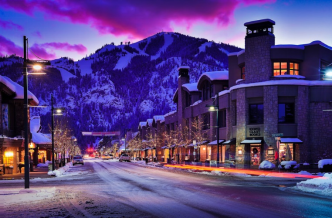
Sun Valley Overview & Street View
₋Sun Valley is a resort city in Blaine County, Idaho, United States. The resort is adjacent to the city of Ketchum and within the greater Wood River valley. The population was 1,406 at the 2010 census, down from 1,427 in 2000. The elevation of Sun Valley (at the Lodge) is 5,920 feet (1,805 m) above sea level. Scheduled passenger airline service is available via the Friedman Memorial Airport located in nearby Hailey, approximately 15 miles (25 km) south. Visitors to Sun Valley are relatively close to the Sawtooth National Recreation Area, accessed over Galena Summit on State Highway 75, the Sawtooth Scenic Byway.
₋Among skiers, the term "Sun Valley" refers to the alpine ski area, which consists of Bald Mountain, the main ski mountain adjacent to Ketchum, and Dollar Mountain, adjacent to Sun Valley, for novice and lower intermediate skiers. Bald Mountain, or "Baldy," has a summit of 9,150 feet (2,790 m) and a vertical drop of 3,400 feet (1,035 m).
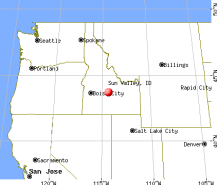
₋With its abundance of constant-pitch terrain, at varying degrees of difficulty, coupled with its substantial vertical drop and absence of wind, Baldy ha s often been referred to as one of the better ski mountains in the world. The treeless "Dollar" at 6,638 feet (2,023 m) has a moderate vertical drop of 628 feet (191 m).
₋The term "Sun Valley" is used more generally to speak of the region surrounding the city, including the neighboring city of Ketchum and the Wood River Valley area winding south to Hailey and Bellevue. The region has been a seasonal home to the rich and famous since first being brought to public attention by Ernest Hemingway in the late 1930s.
III.ECONOMY
₋The average salary in Sun Valley, ID is $58k. Trends in wages decreased by -100.0 percent in Q1 2020. The cost of living in Sun Valley, ID is 100 percent higher than the national average. The most popular occupations in Sun Valley, ID are Executive Chef, Executive Director, and Marketing Director which pay between $35k and $93k per year. The most popular employers in Sun Valley, ID are Sun Valley Company, Sun Valley Center For The Arts, and Sun Valley Lodge.
₋Website: https://www.payscale.com/research/US/Location=Sun-Valley-ID/Salary
IV.Industrial Characteristics
₋The early advancements by the Sun Valley Company may very well have been an innovative catalyst that drove others to follow the spirit of advancement. The spirit to progress the ski industry spread like wildfire throughout the Valley. In what must have been an epic collision of ski bumming and progressive thinking, many ski innovations were born in garages around the valley in the 50’s and 60’s.
₋Edward Scott, sick of clunky bamboo poles, invented the first lightweight aluminum ski pole in 1958. Scott was a ski racer and engineer, and went on to build a gear empire including apparel, bicycles, and the aero bar that helped lead Greg LeMond to his second Tour de France victory in 1989. His company, Scott USA, thrives today on a global scale. Fun Fact: ski film legend Warren Miller rented floor space from Scott during his early years in Sun Valley.
₋When Dr. Bob Smith, DDS, wasn’t tinkering with his dental tools on people’s mouths, he could be found using the same kinds of tools to create a new standard of eyewear in the ski industry. His brilliance developed a ski goggle that utilized double lenses and foam ventilation to reduce the dreaded foggy face typically experienced when shredding the ski hill extra hard. Bob’s innovative behind the ski goggle spurred the creation of Smith Optics. He chose Sun Valley for it’s headquarters to continue the advancement of the goggle and sunglass world. In addition to the powerhouse companies of Scott & Smith, there were countless others progressing the ski industry right here in Sun Valley, Idaho.
₋Ski design legend Mike Brunetto of Research Design Skis and Wolf Skis, as well as Powder Magazine founder Jake Moe (who landed on the idea of a ski magazine “for the people” while ski patrolling on Bald Mountain) both cut their teeth in the Valley.
V.Attractions
1.Bald Mountain
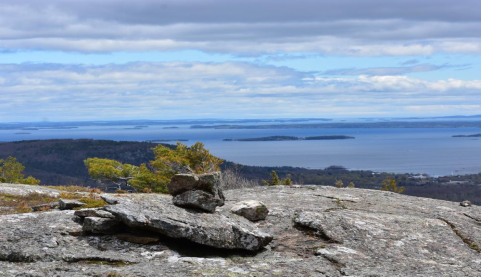
₋Bald Mountain (9150 feet, 2789 m) is a mountain in south central Idaho, adjacent to the city of Ketchum in Blaine County. "Baldy" has one of the higher summits of the Smoky Mountains of Idaho, that are located in the Sawtooth National Forest. The forested Smoky Mountains were named for their propensity to summer forest fires.
₋It is the primary ski mountain of the Sun Valley ski resort, and renowned for its lengthy runs at a uniform gradient, at varying levels of difficulty, and with little wind.
₋In the Sun Valley's fourth year of operation (1939–40), Bald Mountain was opened for lift-served skiing, with a series of three (single-seat) chairlifts, unloading at an elevation of 9020 feet (2749 m),.
₋With a base elevation of 5750 feet (1753 m) along the Big Wood River at River Run, Baldy's vertical drop is 3400 feet (1036 m) along its northeast face. It is served by 14 ski lifts (1 eight-person gondola, 7 high-speed quads, 3 triples, 2 doubles, 1 surface); Baldy has more uphill capacity per skier than any other ski area. It has 75 runs with 2054 acres (8.31 km²) of on-piste skiing, 645 acres (2.61 km²) of which have snowmaking. The slope ratings are 36% easiest, 42% more difficult, and 22% most difficult. These ratings are relative, not absolute; much of the "easiest" terrain on Bald Mountain would be rated as "intermediate" at most ski areas, as the beginner areas are on the gentler and smaller Dollar Mountain.
₋Sun Valley's Bald Mountain is independent of the Bald Mountain Ski Area, a modest ski hill near Pierce in Clearwater County in north central Idaho.
₋Website: https://www.sunvalley.com/mountain-snow-report
2.Sun Valley Museum of Art
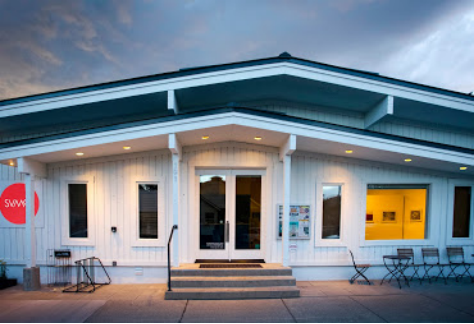
₋Sun Valley Museum of Art is the oldest arts organization in central Idaho’s Wood River Valley. Founded in 1971, The Museum has grown from a few people presenting classes and events to an organization that has over 25,000 people attend events annually (in a valley with a population of 22,000). More than half of those who attended, attended free programs.
₋The Museum's main gallery and staff offices are in Ketchum, Idaho, but the SVMoA also operates a second location in Hailey, Idaho, to better serve the needs of the growing population of southern Blaine County. The Hailey location consists of a historic 100-year-old house that was the birthplace of the poet Ezra Pound and a newly built, state of the art freestanding classroom.
₋In 2006 the Sun Valley Museum of Art received accreditation status from the American Alliance of Museums in recognition of its adherence to the highest standards of operation and programming. Only five percent of America's arts and cultural institutions share this distinction. The Museum is a nonprofit, 501(c)(3) organization.
₋Address: 191 5th St E, Ketchum, ID 83340, United States
₋Phone: +1 208-726-9491
₋Website: https://svmoa.org/home
3.Sun Valley Resort
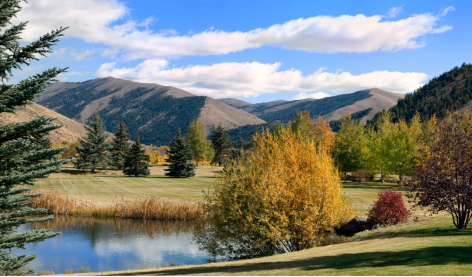
₋Sun Valley Resort is North America's original mountain destination, since 1936. It has the distinction of being the continent's first ski resort - bringing the magic of the European mountain experience to America. Sun Valley was instantly a phenomenon without peer and has since grown to be both the cultural and athletic hub of the Northern Rockies. From the crisp air atop Bald Mountain to the quaint shops and restaurants below, there is no other place quite like Sun Valley, regardless of the season.
₋Address: 1 Sun Valley Rd, Sun Valley, ID 83353, United States
₋Phone: +1 800-786-8259
₋Website: https://www.sunvalley.com/
VI.History
₋Union Pacific Railroad (1936–64)
₋The first destination winter resort in the U.S. was developed by W. Averell Harriman, the chairman of the Union Pacific Railroad, primarily to increase ridership on U.P. passenger trains in the Western United States.
₋The success of the 1932 Winter Olympics in Lake Placid, New York, spurred an increase in participation in winter sports (and alpine skiing in particular). A lifelong skier, Harriman determined that America would embrace a destination mountain resort, similar to those he enjoyed in the Swiss Alps, such as St. Moritz and Davos.
₋During the winter of 1935–36, Harriman enlisted the services of an Austrian Sportsman, Count Felix von Schaffgotsch, to travel across the Western U.S. to locate an ideal site for a winter resort. The Count toured Mount Rainier, Mount Hood, Yosemite, the San Bernardino Mountains, Zion, Rocky Mountain National Park, the Wasatch Range, Pocatello, Jackson Hole, and Grand Targhee areas.
₋Late in his trip and on the verge of abandoning his search for an ideal location for a mountain resort development, he backtracked toward the Ketchum area in central Idaho. A U.P. employee in Boise had casually mentioned that the rail spur to Ketchum cost the company more money for snow removal than any other branch line and the Count went to explore.
₋Schaffgotsch was impressed by the combination of Bald Mountain and its surrounding mountains, adequate snowfall, abundant sunshine, moderate elevation, and absence of wind, and selected it as the site. Harriman visited several weeks later and agreed. The 3,888-acre (15.73 km2) Brass Ranch was purchased for about $4 per acre and construction commenced that spring; it was built in seven months for $1.5 million. Publicist Steve Hannagan named the resort "Sun Valley" and developed the tag line: “Winter sports under a summer sun". (Count Schaffgotsch returned to Austria and was killed on the Eastern Front during World War II.) The centerpiece of the new resort was the Sun Valley Lodge, which opened on December 21, 1936.
₋The 220-room, X-shaped lodge's exterior was constructed of concrete, poured inside rough-sawn forms. The wood grain was impressed on the concrete finish, which was acid-stained brown to imitate wood. The Swiss-style Sun Valley Inn (originally the "Challenger Inn") and village were also part of the initial resort, opening in 1937. Hannagan wanted swimming pools at the resort, "so people won't think skiing is too cold."
₋Both the Lodge and the Inn have heated outdoor swimming pools, circular in shape. Hannagan had the pools designed this way, unique at the time, in the hope they would be widely photographed, providing free publicity, and it worked.
₋Chairlifts
₋The world's first chairlifts were installed on the resort's Proctor and Dollar Mountains in the fall of 1936. (Proctor Mountain is northeast of Dollar Mountain). They have since been removed, but parts of the base of the Proctor Mountain chairlift can still be seen near the Proctor Mountain trail, along with a plaque identifying the area as the location of the world’s first chairlift. Additionally, the original lift operator’s station (now repainted) for the chairlift on Dollar Mountain is still standing. The U.P. chairlift design was adapted by an engineer recalling banana loading conveyor equipment used for tropical fruit ships' cargo. Single-seat chairlifts were developed at the U.P. headquarters in Omaha in the summer of 1936. The chairlift went on to replace primitive rope tow and other adaptations seen at ski areas at the time. The original Proctor Mountain Ski Lift is listed on the National Register of Historic Places.
₋Celebrities
₋Author Ernest Hemingway completed For Whom the Bell Tolls, while staying in suite 206 of the Lodge in the fall of 1939. Averell Harriman had invited Hemingway and other celebrities, primarily from Hollywood, to the resort to help promote it.
₋Gary Cooper was a frequent visitor and hunting/fishing partner, as were Clark Gable, Errol Flynn, Lucille Ball, Marilyn Monroe, and several members of the Kennedy family. Hemingway was a part-time resident over the next twenty years, eventually relocating to Ketchum ("Papa" and his fourth wife are buried in the Ketchum Cemetery). The Hemingway Memorial, dedicated in 1966, is just off Trail Creek Road, about a mile northeast of the Sun Valley Lodge.
₋Sun Valley was featured (and promoted) in the 1941 movie Sun Valley Serenade, starring Sonja Henie, John Payne, Milton Berle, and bandleader Glenn Miller. Scenes were shot at the resort in March 1941. Sun Valley transfer local and future gold medalist Gretchen Fraser was the skiing stand-in for Henie.
₋In February 1958, the cast of "I Love Lucy" filmed an episode of their follow-up series of hour-long specials, known in syndication as "The Lucy-Desi Comedy Hour", at Bald Mountain.
₋In 1971, Apollo 15 astronaut and avid skier Jim Irwin, when stepping upon the surface of the Moon's Hadley–Apennine, exclaimed that it was like Sun Valley.
₋Sun Valley's oldest resident was former actress and silent movie star Barbara Kent. Another resident was actress Ann Sothern, whose career spanned six decades and included 64 movies and 175 television episodes; she is buried in the Ketchum cemetery.
₋Hollywood actor, politician, and businessman, Arnold Schwarzenegger is a frequent visitor of Sun Valley and owns a residence in Ketchum, ID. He has a ski run named after him.
₋World War II
₋During World War II, the resort was closed in 1942 and converted to a convalescent hospital for the U.S. Navy (Pacific Theater), which was operational in July 1943. It re-opened to the public in December 1946.
₋After the war, the resort's clinic operated on the third floor of the northern wing of the Sun Valley Lodge (wing closest to the Trail Creek Rd.) until the Sun Valley Community Hospital was built in 1961. That facility was named after Dr. John Moritz when he retired in 1973; the Nebraska-born surgeon had served as the resort's year-round physician for 33 years. The Moritz Hospital was closed shortly after the new St. Luke's branch hospital opened (south of Ketchum) in November 2000 and the Moritz building now serves as employee housing.
₋Bill Janss (1964–77)
₋After World War II, Harriman focused on his career in government service and the Union Pacific gradually lost interest in the resort. Rail service to Ketchum was discontinued in 1964 and that November the resort was sold to the Janss Investment Company, a major Southern California real estate developer headed by a former Olympic ski team member, Bill Janss (1918–96), founder of Snowmass. (Janss was an alternate on the 1940 team, but the games were cancelled due to the war). The railroad's management had called in the Janss Corporation as consultants and it was determined that it would take a lot of work and no less than $6 million for a face-lifting. The Union Pacific decided to sell and brothers Ed and Bill Janss bid just under $3 million.
₋During this Janss era of ownership, the north-facing Warm Springs area was developed, as well as Seattle Ridge, and condominium and home construction increased significantly. Seven chairlifts were added, and the number of trails increased from 33 to 62. The first two double chairs on Warm Springs were installed in series in 1965; the upper "Limelight" had a 2,200-foot (670 m) vertical rise, the greatest in the U.S. at the time for a chairlift.
₋Bill Janss bought out his brother's share of the resort and gained full control of Sun Valley in 1968. Snowmaking was introduced on a limited basis in the fall of 1975, covering 40 acres (16 ha) up to an elevation of 8,200 feet (2,500 m)
₋The original Seattle Ridge double chairlift was installed in 1976, but due to a very poor snow year in 1976–77 it was not operated until December 20, 1977, christened by local legend Gretchen Fraser. Janss also has a ski run named after him, called "Janss Pass," to the skier's left of the Frenchman's chairlift. Janss' wife Ann, age 54, died in 1973 while helicopter skiing near Sun Valley.
₋Later that year, Janss married Mrs. Glenn Cooper, a widow, family friend, and mother of five, including World Cup racer Christin Cooper, silver medalist in the women's giant slalom at the 1984 Winter Olympics.
₋Under Janss' ownership, the Elkhorn area southeast of Dollar Mountain was developed by the Sun Valley Company and Johns-Manville, beginning in 1972.
₋During excavation, ancient tools dating back nearly 7,000 years were discovered. Elkhorn's golf course was opened in the summer of 1975.
₋Earl Holding (1977–2013)
₋Janss was running low on funds in 1977 and had entered into negotiations to sell the resort to the Walt Disney Company. While the negotiations were strung out by Disney, Earl Holding, a Utah businessman, learned of the situation through a small article in The Wall Street Journal and contacted Janss and arranged for a meeting. For about $12 million, Holding purchased Sun Valley through his company, Sinclair Oil, which operates the Grand America Hotels & Resorts. Holding was initially distrusted by many locals: "Earl is a Four Letter Word" was a popular bumper sticker in the late 1970s in Blaine County. But time proved that Holding did not buy the resort for property speculation; like his other assets he meant to operate and improve for the long-term. One of his first changes was the removal the archaic single-seat chairlift on Exhibition, replacing it with a triple. A daily lift ticket for Baldy during Holding's first season (1977–78) was priced at $13.
₋Under Holding's ownership there have been substantial improvements on the mountain: extensive snowmaking and grooming, high-capacity chairlifts, and the construction of four impressive day lodges, a gondola, and the renovation of the classic Roundhouse restaurant. The resort's golf course was redesigned in the late 1970s by Robert Trent Jones Jr.
₋In 1977, the Warm Springs side boasted 100 acres (0.40 km2) of snowmaking up to an elevation of 8,200 feet (2,500 m), thought to be the highest anywhere at the time. During the late 1980s and early 1990s, snowmaking was significantly expanded on Bald Mountain. Three high-speed quad chairlifts were installed during the summer of 1988 (Christmas, Challenger, & Greyhawk).
₋An impressive day lodge, constructed of logs, river rock, and glass, opened at the base of Warm Springs in the fall of 1992, replacing the 1960s "Northface Hut" cafeteria. Similar day lodges were later opened at the Seattle Ridge summit (1993), and the River Run base (1995). A fire of undetermined origin damaged the Warm Springs lodge in 2018; it occurred shortly after the end of the ski season, while unoccupied at night in mid-April.
₋An older cafeteria, the modest one-floor "Lookout Restaurant," is 120 feet (37 m) below the summit at 9,030 feet (2,750 m), at the top of three chairlifts. Built 47 years ago in 1973, it is the ground floor of a multi-story building that was never completed, resulting in its "basement-like" atmosphere. Nevertheless, the mountain views from this near-summit lodge are quite impressive. However, the resort's recently approved master plan has the facility slated for eventual replacement.
₋Four additional high-speed quads were installed in the 1990s. Two of these replaced older chairlifts on River Run (1992) and Seattle Ridge (1993), and two cut brand new paths: Lookout Express (1993) and Frenchman's (1994). The chairlift from River Run was purchased by Eldora Mountain Resort in Colorado. Baldy's 13 chairlifts have a capacity of over 23,000 skiers per hour. With an average of 3,500 skiers per day (& less than 6,000 skiers per day during peak periods), Sun Valley has kept the lift lines to a minimum, a rarity among major resorts.
₋The Dollar Mountain Lodge opened in November 2004. This day lodge replaces the Dollar Cabin, and also serves as the headquarters for the Sun Valley Ski School. It is similar in construction to the newer day lodges at the big mountain.
₋The interior of the original Sun Valley Lodge has been remodeled twice during Holding's ownership, in 1985 for the golden anniversary and again in 2004. The Sun Valley Inn was also remodeled recently.
₋The Sun Valley Golf Course saw significant improvement in the summer of 2008, with the opening of the new "White Cloud Nine" course on the site of the old Gun Club (relocated further down along Trail Creek road), as well as the opening of the "Sun Valley Club", a full service golf course club house built in the style of the resort's mountain day lodges, replacing a much smaller and older facility.
₋The year also saw the opening of the "Sun Valley Pavilion," built in partnership with the Sun Valley Summer Symphony as a permanent home for the orchestra's annual three-and-a-half-week series of free concerts. The Pavilion is a performing arts facility that has hosted several well-known musical artists and more slated to perform in the near future.
₋In 2009, the resort installed the "Roundhouse Express Gondola" on Bald mountain, which runs from the mountain's River Run Base to the Roundhouse Restaurant (located midway up the mountain, at 7,700 feet (2,350 m). The Exhibition triple chairlift, originally as a single chair in 1939, was removed with the addition of the new 8-passenger lift. The new gondola carries both skiers and non-skiers to the restaurant for lunch and eventually dinner year-round. The Roundhouse Restaurant was built 81 years ago in 1939 and was finished being remodeled to accommodate its new year round role in 2010.
₋Earl Holding died in April 2013 and his family continued to run the resort. In 2006, Forbes magazine estimated that Sun Valley was worth in the range of $300 million.
₋Ski racing
₋In the years before the World Cup circuit, the Harriman Cup at Sun Valley was one of the major ski races held in North America, along with the "Snow Cup" at Alta, the "Roch Cup" at Aspen Mountain, and the "Silver Belt" races at Sugar Bowl, north of Lake Tahoe. Originally known as the "Sun Valley International Open," the Harriman Cup races were the first major international ski competitions held in North America, beginning in 1937. The first three competitions of 1937–39 were held in the Boulder Mountains north of Sun Valley. Beginning in 1940, the Harriman Cup was held on the Warm Springs side of Bald Mountain, decades before chairlifts were installed on that north face of the mountain. American Dick Durrance won three of the first four Harriman Cups, stunning the overconfident Europeans.
₋In the final season before the launch of the World Cup, Sun Valley hosted the world's top racers in 1966 at the "American International" in late March, with a full slate of races for both men and women. With the 1966 World Championships not run until August, it was one of the biggest alpine racing events since the 1964 Olympics. The Austrians swept the men's downhill (Heini Messner, Karl Schranz, and Egon Zimmermann), while Jean-Claude Killy of France won the slalom, with Schranz as runner-up. The two switched places in the one-run giant slalom. Erika Schinegger of Austria, Nancy Greene of Canada, and Marielle Goitschel of France were the top three in the women's downhill, while Goitschel and teammate Annie Famose finished 1–2 in the slalom. Goitschel, Greene, and Famose were the top finishers in the giant slalom and France took the overall team title.
₋In March 1975 and 1977, Sun Valley hosted World Cup ski races, with slalom and giant slalom events for both men and women, run on the Warm Springs side of the mountain.
₋The 1975 slalom was won by Gustavo Thoeni, the dominant World Cup skier of the early 1970s (which turned out to be his last win in the slalom discipline). A young Ingemar Stenmark of Sweden, perhaps the greatest technical ski racer ever, took the giant slalom title both years. Thoeni and Stenmark left Idaho tied in the overall standings in 1975, which Thoeni won in the finals of a parallel slalom the next week in Italy. Phil Mahre of White Pass, Washington, age 19, won the 1977 slalom race over Stenmark, with twin brother Steve placing third. It was Phil's second win (he had won a GS in France in December), but his first victory in the slalom and first in the U.S., and being from the Northwest, very close to home.
₋The present ownership has declined to host any World Cup races since, as it involves closing off runs for a significant time. But during the 2002 Winter Olympics in Salt Lake (about 300 miles (480 km) to the southeast), Sun Valley was used as a training site for many nations' alpine and Nordic ski teams. The alpine speed events for the Olympics were held at a sister resort, Snowbasin, outside of Ogden, Utah.
₋Sun Valley is scheduled to host the U.S. Alpine Championships in 2016 and 2018, held after the World Cup season in March. It last hosted the event in 1951.
₋Olympic medalists from Sun Valley include Gretchen Fraser, Christin Cooper, Picabo Street, snowboarder Kaitlyn Farrington, and disabled skier Muffy Davis, a founding and honorary board member of Sun Valley Adaptive Sports. All five have runs named after them on Bald Mountain: three are on Seattle Ridge (Gretchen's Gold, Christin's Silver (ex-Silver Fox) and Muffy's Medals (ex-Southern Comfort)), Picabo's Street (ex-Plaza) on Warm Springs, and Kaitlyn's Bowl (ex-Farout Bowl) on the Bowls. US TV's legendary sports commentator Tim Ryan (CBS/NBC) also lives in Sun Valley as well as Ski Racing Magazine's proud owner, Gary Black Jr.
VII.Other Information
₋Culture
₋Sun Valley has a lively arts community offering a variety of opportunities through over thirty presenting organizations. Local, regional and nationally known artists are represented through gallery exhibitions, concerts, theater productions, dance productions, film festivals, lectures, opera and symphonic performances.
₋"At an elevation of 5,945 feet (1,812 m), the air in Sun Valley is rarefied- and so is the clientele of the area's top-flight art galleries. Serving the valley's plethora of well-heeled and well-educated art collections are art galleries that could hold their own in Manhattan, Berlin, London or Los Angeles." – Art Ltd Magazine
₋The non-profit Sun Valley Center for the Arts and Humanities was initiated in 1969 by Mrs. Glenn Cooper and Bill Janss, who later married. It attained non-profit status and was officially founded in 1971; the original 5-acre (20,000 m2) campus was located off Dollar Road in Sun Valley. Studios and workshops were open to the public and focused on Ceramics, founded by James Romberg; Photography, founded by Sheri Heiser and Peter deLory; and Fine Arts, founded by David W. Wharton. The SVC offered year-round workshops, lectures, and exhibitions by nationally recognized artists and craft persons to both residents and tourists to Blaine County. Today the Sun Valley Center for the Arts has its main building in nearby Ketchum as well as a historic house and classroom in Hailey, and continues to present an impressive list of guest artists in the visual and performing arts.
₋In 2014, FOCUS Mountain Media, a publishing group based in Sun Valley, launched a quarterly magazine about mountain culture with a specific view towards life in Sun Valley.
₋In 2018, The Argyros Performing Arts Center opened in downtown Ketchum. Since opening, the 450 seat theater has hosted nationally and internationally recognized artists such as Robert Cray, Jean-Yves Thibaudet, Isabella Boylston, Peter Cetera, Kristen Chenoweth, Rita Wilson, and others.
VIII.Contact Information
Government
Mayor: Peter Hendricks
City Hall
Mailing Address
žP.O. Box 10
žSun Valley ID, 83353
Physical Address
ž1 Sun Valley Road
žSun Valley ID, 83353
TEL: (208) 622-2135
Website: https://www.sunvalley.com/contact-info
